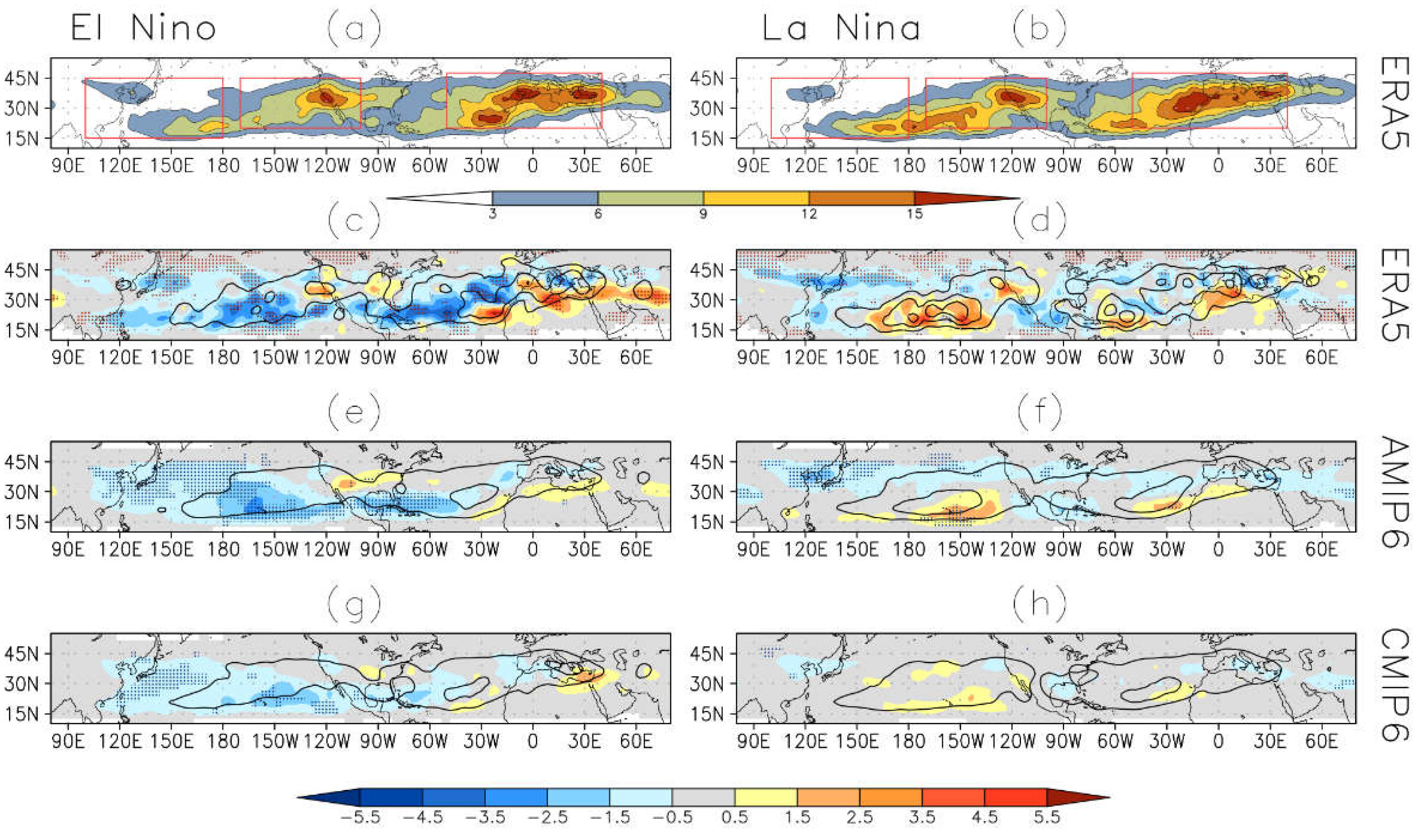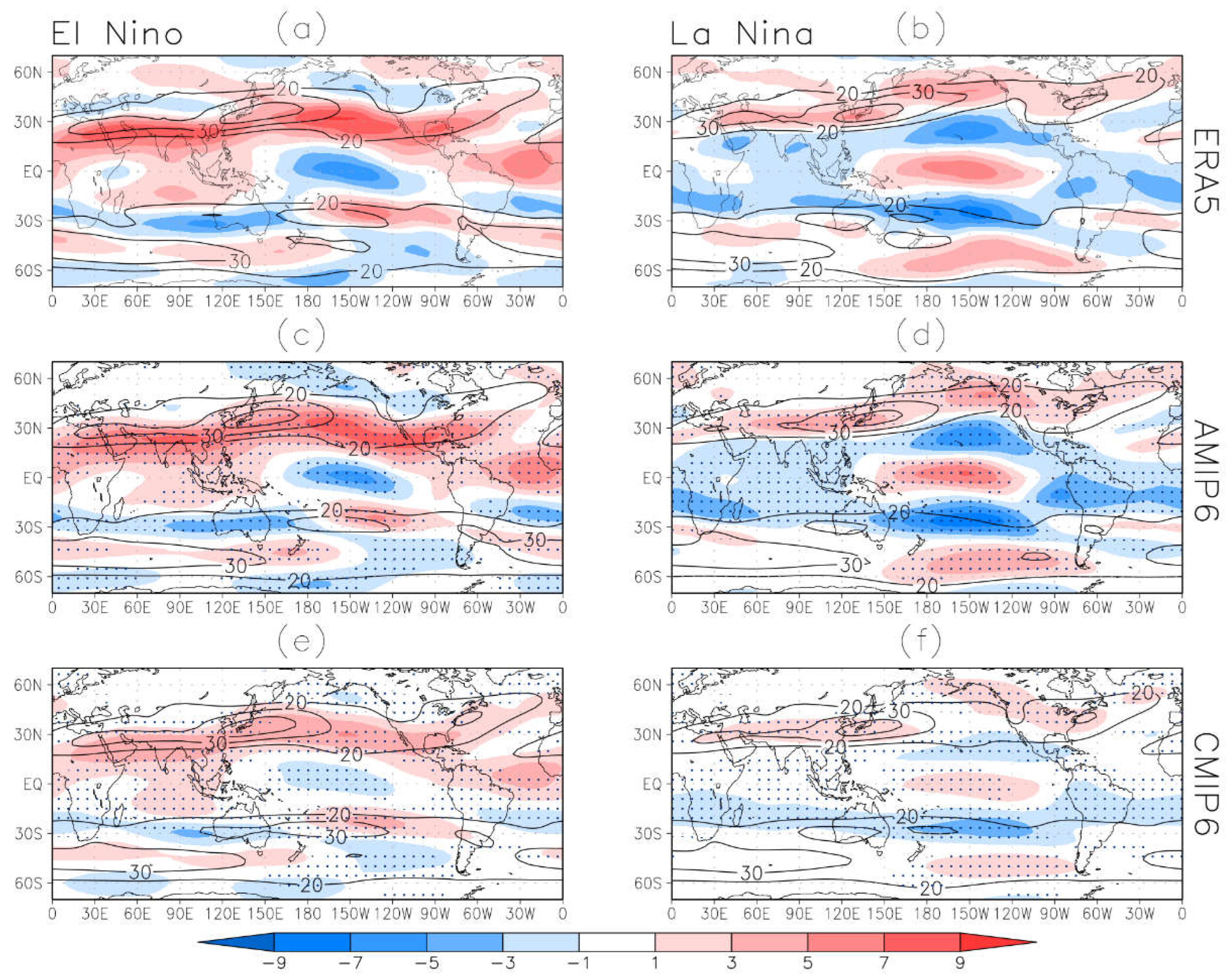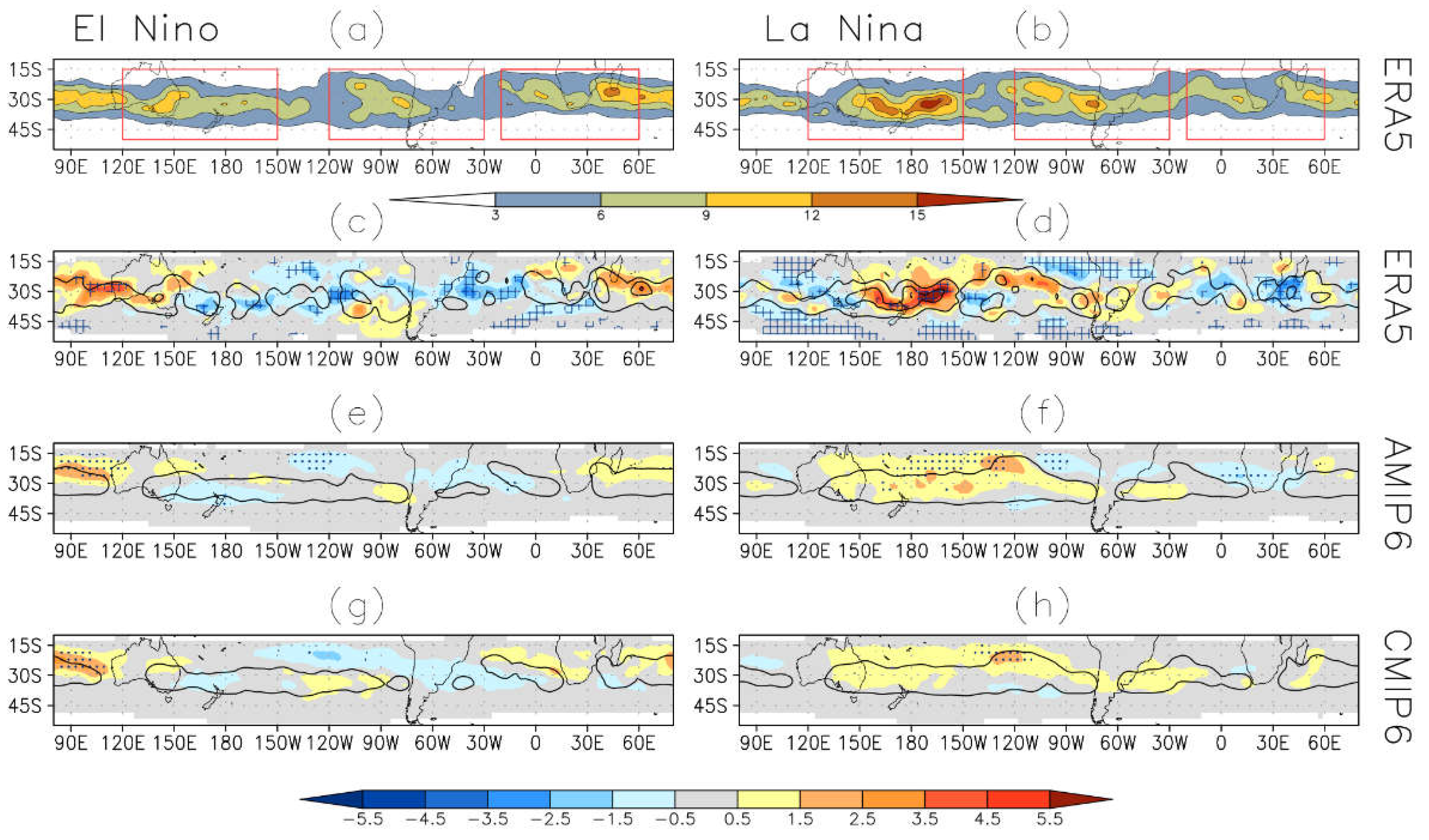Understanding the El Niño Southern Oscillation Effect on Cut-Off Lows as Simulated in Forced SST and Fully Coupled Experiments
Abstract
1. Introduction
2. Data and Analysis Procedures
3. Results
3.1. ERA5
3.1.1. Northern Hemisphere
3.1.2. Southern Hemisphere
3.2. CMIP6 Models
3.2.1. Global SST Bias
3.2.2. Northern Hemisphere
3.2.3. Southern Hemisphere
4. Summary and Conclusions
Supplementary Materials
Author Contributions
Funding
Institutional Review Board Statement
Informed Consent Statement
Data Availability Statement
Conflicts of Interest
References
- Nieto, R.; Sprenger, M.; Wernli, H.; Trigo, R.M.; Gimeno, L. Identification and climatology of cut-off lows near the tropopause. Ann. N. Y. Acad. Sci. 2008, 1146, 256–290. [Google Scholar] [CrossRef]
- Ndarana, T.; Waugh, D.W. The link between cut-off lows and Rossby wave breaking in the Southern Hemisphere. Q. J. R. Meteorol. Soc. 2010, 136, 869–885. [Google Scholar] [CrossRef]
- Bozkurt, D.; Rondanelli, R.; Garreaud, R.; Arriagada, A. Impact of warmer eastern tropical Pacific SST on the March 2015 Atacama floods. Mon. Weather. Rev. 2016, 144, 4441–4460. [Google Scholar] [CrossRef]
- Reyers, M.; Shao, Y. Cutoff lows off the coast of the Atacama Desert under present day conditions and in the Last Glacial Maximum. Glob. Planet. Chang. 2019, 181, 102983. [Google Scholar] [CrossRef]
- Ferreira, R.N. Cut-off lows and extreme precipitation in eastern Spain: Current and future climate. Atmosphere 2021, 12, 835. [Google Scholar] [CrossRef]
- Pinheiro, H.R.; Gan, M.A.; Hodges, K.I.; Ferreira, S.H.S.; Andrade, K.M. Contributions of downstream baroclinic development to strong Southern Hemisphere Cut-off Lows. Q. J. R. Meteorol. Soc. 2021, 148, 214–232. [Google Scholar] [CrossRef]
- Oort, A.H.; Yienger, J.J. Observed interannual variability in the Hadley circulation and its connection to ENSO. J. Clim. 1996, 9, 2751–2767. [Google Scholar] [CrossRef]
- Feng, J.; Li, J.; Xie, F. Long-term variation of the principal mode of boreal spring Hadley circulation linked to SST over the Indo-Pacific warm pool. J. Clim. 2013, 26, 532–544. [Google Scholar] [CrossRef]
- Guo, Y.P.; Li, J.P. Impact of ENSO events on the interannual variability of Hadley circulation extents in boreal winter. Adv. Clim. Chang. Res. 2016, 7, 46–53. [Google Scholar] [CrossRef]
- Risbey, J.S.; Pook, M.J.; McIntosh, P.C.; Ummenhofer, C.C.; Meyers, G. Characteristics and variability of synoptic features associated with cool season rainfall in southeastern Australia. Int. J. Climatol. A J. R. Meteorol. Soc. 2009, 29, 595–1613. [Google Scholar] [CrossRef]
- Nieto, R.; Gimeno, L.; de la Torre, L.; Ribera, P.; Barriopedro, D.; García-Herrera, R.; Serrano, A.; Gordillo, A.; Redano, A.; Lorente, J. Interannual variability of cut-off low systems over the European sector: The role of blocking and the Northern Hemisphere circulation modes. Meteorol. Atmos. Phys. 2007, 96, 85–101. [Google Scholar] [CrossRef]
- Singleton, A.T.; Reason, C.J.C. Variability in the characteristics of cut-off low pressure systems over subtropical southern Africa. Int. J. Climatol. A J. R. Meteorol. Soc. 2007, 27, 295–310. [Google Scholar] [CrossRef]
- Favre, A.; Hewitson, B.; Tadross, M.; Lennard, C.; Cerezo-Mota, R. Relationships between cut-off lows and the semiannual and southern oscillations. Clim. Dyn. 2012, 38, 1473–1487. [Google Scholar] [CrossRef]
- Fuenzalida, H.; Sánchez, R.; Garreaud, R. A climatology of cutoff lows in the Southern Hemisphere. J. Geophys. Res. 2005, 110, 1–10. [Google Scholar] [CrossRef]
- Muñoz, C.; Schultz, D.; Vaughan, G. A midlatitude climatology and interannual variability of 200-and 500-hPa cut-off lows. J. Clim. 2020, 33, 2201–2222. [Google Scholar] [CrossRef]
- Neelin, J.D.; Latif, M.; Allaart, M.A.F.; Cane, M.A.; Cubasch, U.; Gates, W.L.; Gent, P.R.; Ghil, M.; Gordon, C.; Lau, N.C.; et al. Tropical air-sea interaction in general circulation models. Clim. Dyn. 1992, 7, 73–104. [Google Scholar] [CrossRef]
- Delecluse, P.; Davey, M.K.; Kitamura, Y.; Philander, S.G.H.; Suarez, M.; Bengtsson, L. Coupled general circulation modeling of the tropical Pacific. J. Geophys. Res. 1998, 103, 14357–14373. [Google Scholar] [CrossRef]
- Latif, M.; Sperber, K.; Arblaster, J.; Braconnot, P.; Chen, D.; Colman, A.; Cubasch, U.; Cooper, C.; Delecluse, P.; DeWitt, D.; et al. ENSIP: The El Nino simulation intercomparison project. Clim. Dyn. 2001, 18, 255–276. [Google Scholar] [CrossRef]
- Davey, M.; Huddleston, M.; Sperber, K.; Braconnot, P.; Bryan, F.; Chen, D.; Colman, R.; Cooper, C.; Cubasch, U.; Delecluse, P.; et al. STOIC: A study of coupled model climatology and variability in tropical regions. Clim. Dyn. 2002, 18, 403–420. [Google Scholar]
- AchutaRao, K.; Sperber, K.R. ENSO simulation in coupled ocean-atmosphere models: Are the current models better? Clim. Dyn. 2006, 27, 1–15. [Google Scholar] [CrossRef]
- Pinheiro, H.; Ambrizzi, T.; Hodges, K.; Gan, M.; Andrade, K.; Garcia, J. Are Cut-off Lows Simulated Better in CMIP6 Compared to CMIP5? Clim. Dyn. 2022, 1–20. [Google Scholar] [CrossRef]
- Van den Dool, H.M. Empirical Methods in Short-Term Climate Prediction; Oxford University Press Inc.: New York, NY, USA, 2007; pp. 1–226. [Google Scholar]
- Hersbach, H.; Dee, D. ERA5 reanalysis is in production. ECMWF Newsl. 2016, 147, 7. [Google Scholar]
- Dee, D.P.; Uppala, S.M.; Simmons, A.J.; Berrisford, P.; Poli, P.; Kobayashi, S.; Vitart, F. The ERA-Interim reanalysis: Configuration and performance of the data assimilation system. Q. J. R. Meteorol. Soc. 2011, 137, 553–597. [Google Scholar] [CrossRef]
- Hodges, K.I. A general method for tracking analysis and its application to meteorological data. Mon. Weather. Rev. 1994, 122, 2573–2586. [Google Scholar] [CrossRef]
- Hodges, K.I. Spherical nonparametric estimators applied to the UGAMP model integration for AMIP. Mon. Weather. Rev. 1996, 124, 2914–2932. [Google Scholar] [CrossRef]
- Hodges, K.I. Adaptive constraints for feature tracking. Mon. Weather. Rev. 1999, 127, 1362–1373. [Google Scholar] [CrossRef]
- Pinheiro, H.R.; Hodges, K.I.; Gan, M.A. Sensitivity of identifying cut-off lows in the Southern Hemisphere using multiple criteria: Implications for numbers, seasonality and intensity. Clim. Dyn. 2019, 53, 6699–6713. [Google Scholar] [CrossRef]
- Torrence, C.; Webster, P.J. Interdecadal changes in the ENSO–monsoon system. J. Clim. 1999, 12, 2679–2690. [Google Scholar] [CrossRef]
- Jevrejeva, S.; Moore, J.C.; Grinsted, A. Influence of the Arctic Oscillation and El Niño-Southern Oscillation (ENSO) on ice conditions in the Baltic Sea: The wavelet approach. J. Geophys. Res. Atmos. 2003, 108, D21. [Google Scholar] [CrossRef]
- Keener, V.W.; Feyereisen, G.W.; Lall, U.; Jones, J.W.; Bosch, D.D.; Lowrance, R. El-Niño/Southern Oscillation (ENSO) influences on monthly NO3 load and concentration, stream flow and precipitation in the Little River Watershed, Tifton, Georgia (GA). J. Hydrol. 2010, 381, 352–363. [Google Scholar] [CrossRef]
- Mokhov, I.I.; Smirnov, D.A.; Nakonechny, P.I.; Kozlenko, S.S.; Kurths, J. Relationship between El-Niño/Southern oscillation and the Indian monsoon. Izvestiya. Atmos. Ocean. Phys. 2012, 48, 47–56. [Google Scholar] [CrossRef]
- Wahiduzzaman, M.; Luo, J.J. A statistical analysis on the contribution of El Niño–Southern Oscillation to the rainfall and temperature over Bangladesh. Meteorol. Atmos. Phys. 2021, 133, 55–68. [Google Scholar] [CrossRef]
- Price, J.D.; Vaughan, G. Statistical studies of cut-off-low systems. In Annales Geophysicae (1988); European Geophysical Society: Katlenburg-Lindau, Germany, 1992; Volume 10, pp. 96–102. [Google Scholar]
- Kentarchos, A.S.; Davies, T.D. A climatology of cut-off lows at 200 hPa in the Northern Hemisphere, 1990–1994. Int. J. Climatol. A J. R. Meteorol. Soc. 1998, 18, 379–390. [Google Scholar] [CrossRef]
- Nieto, R.; Gimeno, L.; de La Torre, L.; Ribera, P.; Gallego, D.; García-Herrera, R.; García, J.A.; Nuñez, M.; Redaño, A.; Lorente, J. Climatological features of cutoff low systems in the Northern Hemisphere. J. Clim. 2005, 18, 3085–3103. [Google Scholar] [CrossRef]
- Wernli, H.; Sprenger, M. Identification and ERA-15 climatology of potential vorticity streamers and cutoffs near the extratropical tropopause. J. Atmos. Sci. 2007, 64, 1569–1586. [Google Scholar] [CrossRef]
- Livezey, R.E.; Chen, W.Y. Statistical field significance and its determination by Monte Carlo techniques. Mon. Weather Rev. 1983, 111, 46–59. [Google Scholar] [CrossRef]
- Cubasch, U.; Santer, B.D.; Hellbach, A.; Hegerl, G.; Höck, H.; Maier-Reimer, E.; Voss, R. Monte Carlo climate change forecasts with a global coupled ocean-atmosphere model. Clim. Dyn. 1994, 10, 1–19. [Google Scholar] [CrossRef]
- Yuan, Y.; Yan, H. Different types of La Niña events and different responses of the tropical atmosphere. Chin. Sci. Bull. 2013, 58, 406–415. [Google Scholar] [CrossRef]
- Ropelewski, C.F.; Halpert, M.S. North American precipitation and temperature patterns associated with the El Niño/Southern Oscillation (ENSO). Mon. Weather. Rev. 1986, 114, 2352–2362. [Google Scholar] [CrossRef]
- Chiodi, A.M.; Harrison, D.E. Global seasonal precipitation anomalies robustly associated with El Niño and La Niña events—An OLR perspective. J. Clim. 2015, 28, 6133–6159. [Google Scholar] [CrossRef]
- Azizi, G. Identification and Climatology of Cut-off Lows over IRAN and Relationships with ENSO and NAO. Geogr. Res. Q. J. 2018, 33, 158–173. [Google Scholar] [CrossRef]
- Wang, C.; Weisberg, R.H.; Virmani, J.I. Western Pacific interannual variability associated with the El Niño-Southern Oscillation. J. Geophys. Res. Ocean. 1999, 104, 5131–5149. [Google Scholar] [CrossRef]
- Barnett, T.P. The interaction of multiple time scales in the tropical climate system. J. Clim. 1991, 4, 269–285. [Google Scholar] [CrossRef]
- Goswami, B.N.; Shukla, J. Predictability of a coupled ocean–atmosphere model. J. Clim. 1991, 4, 107–115. [Google Scholar] [CrossRef][Green Version]
- Chang, P. A study of the seasonal cycle of sea surface temperature in the tropical Pacific Ocean using reduced gravity models. J. Geophys. Res. 1994, 99, 7725–7741. [Google Scholar] [CrossRef]
- Tziperman, E.; Stone, L.; Cane, M.; Jarosh, H. El Niño chaos: Overlapping of resonances between the seasonal cycle and the Pacific ocean–atmosphere oscillator. Science 1994, 264, 72–74. [Google Scholar] [CrossRef] [PubMed]
- Tziperman, E.; Zebiak, S.E.; Cane, M.A. Mechanisms of seasonal–ENSO interaction. J. Atmos. Sci. 1997, 54, 61–71. [Google Scholar] [CrossRef]
- Huang, R.; Zhang, R.; Yan, B. Dynamical effect of the zonal wind anomalies over the tropical western Pacific on ENSO cycles. Sci. China Ser. D Earth Sci. 2001, 44, 1089–1098. [Google Scholar] [CrossRef]
- Newman, M.; Shin, S.I.; Alexander, M.A. Natural variation in ENSO flavors. Geophys. Res. Lett. 2011, 38, 1–7. [Google Scholar] [CrossRef]
- McGregor, S.; Ramesh, N.; Spence, P.; England, M.H.; McPhaden, M.J.; Santoso, A. Meridional movement of wind anomalies during ENSO events and their role in event termination. Geophys. Res. Lett. 2013, 40, 749–754. [Google Scholar] [CrossRef]
- Zhao, B.; Fedorov, A. The effects of background zonal and meridional winds on ENSO in a coupled GCM. J. Clim. 2020, 33, 2075–2091. [Google Scholar] [CrossRef]
- Seager, R.; Harnik, N.; Kushnir, Y.; Robinson, W.; Miller, J. Mechanisms of hemispherically symmetric climate variability. J. Clim. 2003, 16, 2960–2978. [Google Scholar] [CrossRef]
- Lu, J.; Chen, G.; Frierson, D.M. Response of the zonal mean atmospheric circulation to El Niño versus global warming. J. Clim. 2008, 21, 5835–5851. [Google Scholar] [CrossRef]
- Gong, T.; Feldstein, S.B.; Luo, D. The impact of ENSO on wave breaking and southern annular mode events. J. Atmos. Sci. 2010, 67, 2854–2870. [Google Scholar] [CrossRef]
- Oliveira, F.N.; Carvalho, L.M.; Ambrizzi, T. A new climatology for Southern Hemisphere blockings in the winter and the combined effect of ENSO and SAM phases. Int. J. Climatol. 2014, 34, 676–1692. [Google Scholar] [CrossRef]
- Hoskins, B.J.; McIntyre, M.E.; Robertson, A.W. On the use and significance of isentropic potential vorticity maps. Q. J. R. Meteorol. Soc. 1985, 111, 877–946. [Google Scholar] [CrossRef]
- Pinheiro, H.R.; Hodges, K.I.; Gan, M.A. An intercomparison of subtropical cut-off lows in the Southern Hemisphere using recent reanalyses: ERA-Interim, NCEP-CFRS, MERRA-2, JRA-55, and JRA-25. Clim. Dyn. 2020, 54, 777–792. [Google Scholar] [CrossRef]
- Torrence, C.; Compo, G.P. A practical guide to wavelet analysis. Bull. Am. Meteorol. Soc. 1998, 79, 61–78. [Google Scholar] [CrossRef]
- Yu, J.Y.; Mechoso, C.R. Links between annual variations of Peruvian stratocumulus clouds and of SST in the eastern equatorial Pacific. J. Clim. 1999, 12, 3305–3318. [Google Scholar] [CrossRef]
- Cassou, C.; Deser, C.; Terray, L.; Hurrell, J.W.; Drévillon, M. Summer sea surface temperature conditions in the North Atlantic and their impact upon the atmospheric circulation in early winter. J. Clim. 2004, 17, 3349–3363. [Google Scholar] [CrossRef]
- Hannak, L.; Knippertz, P.; Fink, A.H.; Kniffka, A.; Pante, G. Why do global climate models struggle to represent low-level clouds in the West African summer monsoon? J. Clim. 2017, 30, 665–1687. [Google Scholar] [CrossRef]
- Sun, Y.; Sun, D.Z.; Wu, L.; Wang, F. Western Pacific warm pool and ENSO asymmetry in CMIP3 models. Adv. Atmos. Sci. 2013, 30, 940–953. [Google Scholar] [CrossRef]
- Zhang, T.; Sun, D.Z. ENSO asymmetry in CMIP5 models. J. Clim. 2014, 27, 4070–4093. [Google Scholar] [CrossRef]
- Stockdale, T.N.; Balmaseda, M.A.; Vidard, A. Tropical Atlantic SST prediction with coupled ocean–atmosphere GCMs. J. Clim. 2006, 19, 6047–6061. [Google Scholar] [CrossRef]
- McKenna, S.; Santoso, A.; Gupta, A.S.; Taschetto, A.S.; Cai, W. Indian Ocean Dipole in CMIP5 and CMIP6: Characteristics, biases, and links to ENSO. Sci. Rep. 2020, 10, 1–13. [Google Scholar] [CrossRef]
- Zhao, Y.; Sun, D.Z. ENSO Asymmetry in CMIP6 Models. J. Clim. 2022, 1–42. [Google Scholar] [CrossRef]
- Van Oldenborgh, G.J.; Philip, S.Y.; Collins, M. El Niño in a changing climate: A multi-model study. Ocean. Sci. 2005, 1, 81–95. [Google Scholar] [CrossRef]
- Kang, I.S.; Kug, J.S. El Niño and La Niña sea surface temperature anomalies: Asymmetry characteristics associated with their wind stress anomalies. J. Geophys. Res. Atmos. 2002, 107, ACL 1-10. [Google Scholar] [CrossRef]
- An, S.I.; Ham, Y.G.; Kug, J.S.; Jin, F.F.; Kang, I.S. El Niño–La Niña asymmetry in the coupled model intercomparison project simulations. J. Clim. 2005, 18, 2617–2627. [Google Scholar] [CrossRef]
- Zhang, T.; Sun, D.Z.; Neale, R.; Rasch, P.J. An evaluation of ENSO asymmetry in the Community Climate System Models: A view from the subsurface. J. Clim. 2009, 22, 5933–5961. [Google Scholar] [CrossRef]
- Hagedorn, R.; Doblas-Reyes, F.J.; Palmer, T.N. The rationale behind the success of multi-model ensembles in seasonal forecasting—I. Basic concept. Tellus A Dyn. Meteorol. Oceanogr. 2005, 57, 219–233. [Google Scholar]
- Jin, E.K.; Kinter, J.L.; Wang, B.; Park, C.K.; Kang, I.S.; Kirtman, B.P.; Kug, J.S.; Kumar, A.; Luo, J.J.; Schemm, J.; et al. Current status of ENSO prediction skill in coupled ocean–atmosphere models. Clim. Dyn. 2008, 31, 647–664. [Google Scholar] [CrossRef]
- Sohn, S.J.; Tam, C.Y.; Jeong, H.I. How do the strength and type of ENSO affect SST predictability in coupled models. Sci. Rep. 2016, 6, 1–8. [Google Scholar] [CrossRef] [PubMed][Green Version]





| Model Name | Model Expansion | Institution | Atmospheric Resolution | No. of Ensembles | ||
|---|---|---|---|---|---|---|
| Horizontal | Vertical | AMIP | Historical | |||
| ACCESS-CM2 | Australian Community | Centre for Australian Weather | N96 | 85 | 3 | 1 (1) |
| Climate | ||||||
| and Earth System Simulator | and Climate Research | (192 × 144) | ||||
| (ACCESS) with U.K. Met Office | (CAWCR), Australia | |||||
| Global Atmosphere (GA) | ||||||
| ACCESS-ESM1-5 | ACCESS with HadGEM2 | N96 | 38 | 3 | 3 (3) | |
| (version 1.1) | (192 × 144) | |||||
| BCC-CSM2-MR | Beijing Climate Center (BCC) | BCC, China | T106 | 46 | 3 | 1 (1) |
| Climate System Model version 2, | (320 × 160) | |||||
| medium resolution | ||||||
| IPSL-CM6A-LR | L’Institut Pierre-Simon Laplace | IPSL, France | N96 (144 × 143) | 79 | 9 | 10 (10) |
| (IPSL) Coupled Model, version 5, | (320 × 160) | |||||
| coupled with the Nucleus for | ||||||
| MIROC6 | Model for Interdisciplinary | MIROC, Japan | T85 | 81 | 10 | 9 (9) |
| Research on Climate (MIROC), | (256 × 128) | |||||
| version 6 | ||||||
| MIROC-ES2L | MIROC Earth System | T42 | 40 | 3 | 3 (3) | |
| (version 2) Long-term | (128 × 64) | |||||
| simulations | ||||||
| MRI-ESM2-0 | Meteorological Research Institute | MRI, Japan | TL159 | 80 | 3 | 5 (3) |
| (MRI) Earth System Model, | (320 × 160) | |||||
| version 2.0 | ||||||
| NorESM2-LM | Norwegian Earth System Model, | Norwegian Climate Centre | 144 × 96 | 32 | 1 | 2 (1) |
| version 2, medium resolution | (NCC), Norway | |||||
| Period | Northern Hemisphere | Southern Hemisphere | ||
|---|---|---|---|---|
| Niño | Niña | Niño | Niña | |
| DJF | 0.0 (0.0) | 9.8 (11.2) | −8.9 (−6.1) | 9.9 (6.8) |
| MAM | −13.3 (−10.9) | 6.0 (4.9) | −7.0 (−5.4) | −7.7 (−5.9) |
| JJA | −8.0 (−4.0) | 4.5 (2.2) | −8.8 (−12.9) | 0.2 (0.2) |
| SON | −12.0 (−7.2) | −8.5 (−5.1) | −14.0 (−15.0) | −2.3 (−2.4) |
Publisher’s Note: MDPI stays neutral with regard to jurisdictional claims in published maps and institutional affiliations. |
© 2022 by the authors. Licensee MDPI, Basel, Switzerland. This article is an open access article distributed under the terms and conditions of the Creative Commons Attribution (CC BY) license (https://creativecommons.org/licenses/by/4.0/).
Share and Cite
Pinheiro, H.R.; Ambrizzi, T.; Hodges, K.I.; Gan, M.A. Understanding the El Niño Southern Oscillation Effect on Cut-Off Lows as Simulated in Forced SST and Fully Coupled Experiments. Atmosphere 2022, 13, 1167. https://doi.org/10.3390/atmos13081167
Pinheiro HR, Ambrizzi T, Hodges KI, Gan MA. Understanding the El Niño Southern Oscillation Effect on Cut-Off Lows as Simulated in Forced SST and Fully Coupled Experiments. Atmosphere. 2022; 13(8):1167. https://doi.org/10.3390/atmos13081167
Chicago/Turabian StylePinheiro, Henri R., Tercio Ambrizzi, Kevin I. Hodges, and Manoel A. Gan. 2022. "Understanding the El Niño Southern Oscillation Effect on Cut-Off Lows as Simulated in Forced SST and Fully Coupled Experiments" Atmosphere 13, no. 8: 1167. https://doi.org/10.3390/atmos13081167
APA StylePinheiro, H. R., Ambrizzi, T., Hodges, K. I., & Gan, M. A. (2022). Understanding the El Niño Southern Oscillation Effect on Cut-Off Lows as Simulated in Forced SST and Fully Coupled Experiments. Atmosphere, 13(8), 1167. https://doi.org/10.3390/atmos13081167






